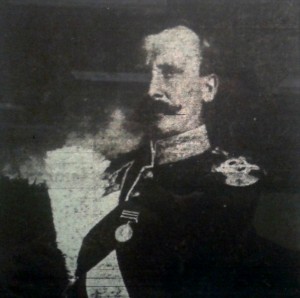Charms of Life in the Trenches
Lieutenant George Samuel Ager, 16th Battalion CEF
As time advances from one Great War anniversary to the next, I engage my grey cells in an exercise to find connection with the Canadian Expeditionary Force of April 22 – 24, 1915. Specifically I search for something personal, a familar name to speak to the area northeast of Ypres, the first German gas attack and the battle of Kitcheners’ Wood.
When searching for these deeper connections I attempt to discover new information, something previously unknown to me, and perhaops something seemingly unrelated yet a twist brings the connection together. This time perhaps a name – a face to highlight when the 16th was beginning its experience that was to be their initial entry into the Great War.
I turn to a familiar resource, the University of Victoria, and begin the steady plod through a Victoria newspaper of the time. As I near April 1915 I discover an image and one name to focus upon, George Samuel Ager, a veteran of the Second Boer War (1899-1902). Ager served with Lord Strathcona’s Horse of the Canadian Cavalry and after the Boer War Ager was employed by Beaumont Boggs as the managing director of the Canada Mosaic Tile Company Ltd. (Victoria, B.C.). The firm manufactured and imported mantles, tiles, grates and art stone and for a city, such as Victoria, which today takes great pride in its built heritage I wonder how much of the firm’s work remains in situ and what the works they created and brought into the country may have looked like.
At the time of Ager’s enlistment in September 1914, we learn from his attestation papers that he was married to Maud and that on his left arm there was a tattoo, the initials “S.H.” possibly for “Stratchcona’s Horse”. In pre-Great War Victoria Ager served as a Captain with the 50th Regiment (Gordon Highlanders) but with the 16th Battalion CEF served in a lower officer’s rank as Lieutenant.
Returning to the grey cells it is while reading through the pages of the Victoria Daily Times that I find a page four 31 March 1915 article related to George Samuel Ager entitled, “Fighting in Mud and Blood of Trenches”. The article, in effect a summarized 9 March 1915 letter from Captain Ager to his wife Maud, is a “vivid description of Life in Letter from Captain [sic] Ager”.
“The Canadian contingent has now been initiated into the charms of the life in the trenches…The trenches we occupied were in a wretched condition, very muddy and wet…At our part of the line the trenches are about 250 yards apart, but to our right a little they are within 40 yards of each other. Both sides have a maze of barbed wire entanglements in front of their trenches…the Germans…place their rifles in and keep them stationary sighted to shoot immediately over the tops of our parapets, thus getting a direct aim in our trenches at night…Every day we have an artillery duel, and the men seem to thoroughly enjoy hearing the shells screeching through the air…as long as the men remain in the trenches below the parapets they are safe, but the men will take chances, do foolish things and so get picked off occasionally. During the night the Germans turn on big searchlights at various intervals and if they can locate troops moving in or working parties immediately turn on their machine guns…During the four days I was in the trench I had only three hours sleep…Of course the whole time you are in the trenches you do not remove any of your clothing and four days with practically no sleep and continually ploughing through mud is not conducive to the most cheerful spirit…The weather is very cold at the present time and at this moment I am shivering. Every time it rains it raises the very mischief in the trenches, making them slide in in various places, and of course creating more mud. The mud here is the stickiest I have ever seen…It is sometimes impossible to pull your feet out…It creates havoc with your socks…”
However, there would be no more letters from the good Lieutenant George Samuel Ager as on 22 April 1915 Ager was reported wounded, then wounded and missing and some time later “for official purposes presumed to have died on or since April 22, 1915”. Having no known grave Lieutenant George Samuel Ager is commemorated on the Ypres (Menin Gate) Memorial, Ieper, Belgium.
Together with friends I have wandered the area of the first gas attack, Kitcheners’ Wood, the surrounding area and Ager’s footsteps. Taking in the lay of the land, standing and observing where Canadians many years previously had stood within a torrent of fire, shellburst and mayhem I recall the feelings we all shared as we thought back upon this place in which our feet were now grounded but from which we could all move forward to the next site of memory.
It was while wandering to another of these sites of memory, Ploegsteert Churchyard, that we came upon the graves of some Canadian soldiers killed during training and where the son of Beaumont Boggs, for whom Lieutenant Ager worked, is buried. Lieutenant Herbert Beaumont Boggs of the 7th Canadian Infantry Battalion was one of the first Canadian officers killed during the Great War having lost his life February 26, 1915 while in training for front line duty on the Western Front.
For this observer of history it is these twists of fate, these historical mazes of the implausible that continue to intrigue me to seek connection. Exploring the twists and turns lets me find the stories that once lingered by the fireside but now retold for today’s generation of remembrance.


Comments